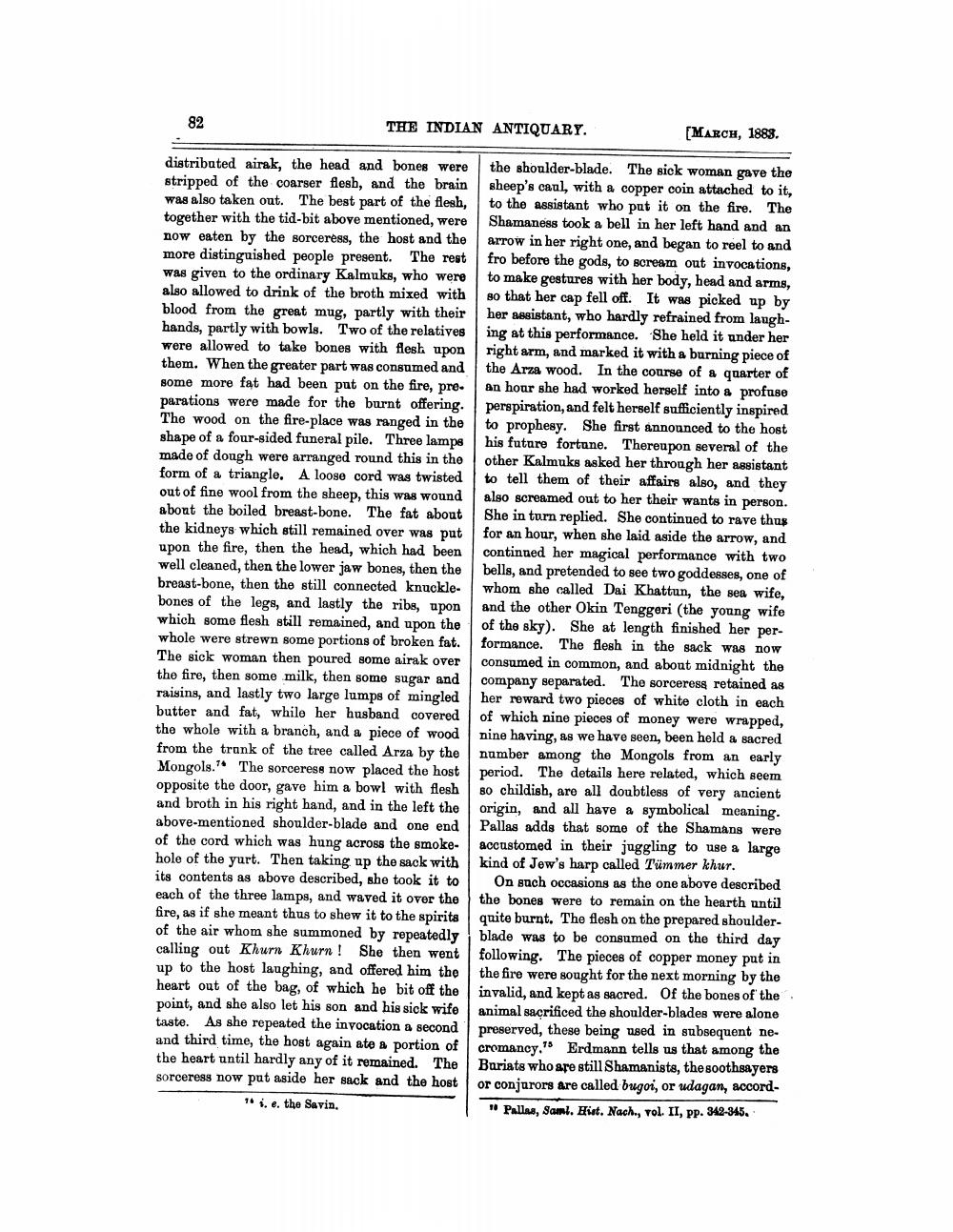________________
82
THE INDIAN ANTIQUARY.
distributed airak, the head and bones were stripped of the coarser flesh, and the brain was also taken out. The best part of the flesh, together with the tid-bit above mentioned, were now eaten by the sorceress, the host and the more distinguished people present. The rest was given to the ordinary Kalmuks, who were also allowed to drink of the broth mixed with blood from the great mug, partly with their hands, partly with bowls. Two of the relatives were allowed to take bones with flesh upon them. When the greater part was consumed and some more fat had been put on the fire, preparations were made for the burnt offering. The wood on the fire-place was ranged in the shape of a four-sided funeral pile. Three lamps made of dough were arranged round this in the form of a triangle. A loose cord was twisted out of fine wool from the sheep, this was wound about the boiled breast-bone. The fat about the kidneys which still remained over was put upon the fire, then the head, which had been well cleaned, then the lower jaw bones, then the breast-bone, then the still connected knucklebones of the legs, and lastly the ribs, upon which some flesh still remained, and upon the whole were strewn some portions of broken fat. The sick woman then poured some airak over the fire, then some milk, then some sugar and raisins, and lastly two large lumps of mingled butter and fat, while her husband covered the whole with a branch, and a piece of wood from the trunk of the tree called Arza by the Mongols. The sorceress now placed the host opposite the door, gave him a bowl with flesh and broth in his right hand, and in the left the above-mentioned shoulder-blade and one end of the cord which was hung across the smokehole of the yurt. Then taking up the sack with its contents as above described, she took it to each of the three lamps, and waved it over the fire, as if she meant thus to shew it to the spirits of the air whom she summoned by repeatedly calling out Khurn Khurn! She then went up to the host laughing, and offered him the heart out of the bag, of which he bit off the point, and she also let his son and his sick wife taste. As she repeated the invocation a second and third time, the host again ate a portion of the heart until hardly any of it remained. The sorceress now put aside her sack and the host
7. e. the Savin.
[MARCH, 1883.
the shoulder-blade. The sick woman gave the sheep's caul, with a copper coin attached to it, to the assistant who put it on the fire. The Shamaness took a bell in her left hand and an arrow in her right one, and began to reel to and fro before the gods, to scream out invocations, to make gestures with her body, head and arms, so that her cap fell off. It was picked up by her assistant, who hardly refrained from laughing at this performance. She held it under her right arm, and marked it with a burning piece of the Arza wood. In the course of a quarter of an hour she had worked herself into a profuse perspiration, and felt herself sufficiently inspired to prophesy. She first announced to the host his future fortune. Thereupon several of the other Kalmuks asked her through her assistant to tell them of their affairs also, and they also screamed out to her their wants in person. She in turn replied. She continued to rave thus for an hour, when she laid aside the arrow, and continued her magical performance with two bells, and pretended to see two goddesses, one of whom she called Dai Khattun, the sea wife, and the other Okin Tenggeri (the young wife of the sky). She at length finished her performance. The flesh in the sack was now consumed in common, and about midnight the company separated. The sorceress retained as her reward two pieces of white cloth in each of which nine pieces of money were wrapped, nine having, as we have seen, been held a sacred number among the Mongols from an early period. The details here related, which seem so childish, are all doubtless of very ancient origin, and all have a symbolical meaning. Pallas adds that some of the Shamans were accustomed in their juggling to use a large kind of Jew's harp called Tümmer khur.
On such occasions as the one above described the bones were to remain on the hearth until quite burnt. The flesh on the prepared shoulderblade was to be consumed on the third day following. The pieces of copper money put in the fire were sought for the next morning by the invalid, and kept as sacred. Of the bones of the animal sacrificed the shoulder-blades were alone preserved, these being used in subsequent necromancy." Erdmann tells us that among the Buriats who are still Shamanists, the soothsayers or conjurors are called bugoi, or udagan, accord"Pallas, Sami. Hist. Nach., vol. II, pp. 342-345.




